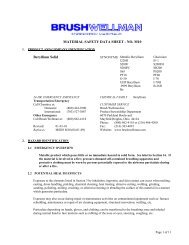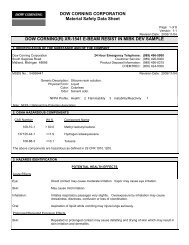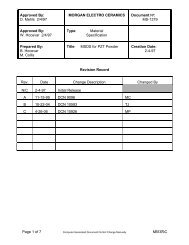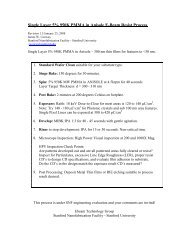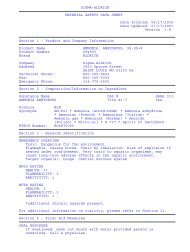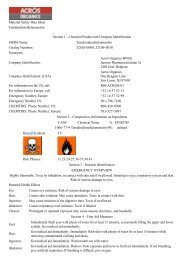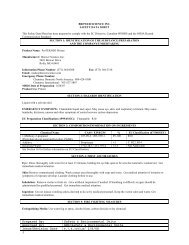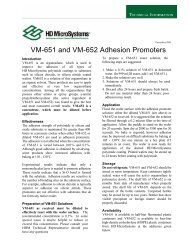BSI Document No. F.7.6.1133.B Page 1 of 4 Effective Date: 7/25/02 ...
BSI Document No. F.7.6.1133.B Page 1 of 4 Effective Date: 7/25/02 ...
BSI Document No. F.7.6.1133.B Page 1 of 4 Effective Date: 7/25/02 ...
You also want an ePaper? Increase the reach of your titles
YUMPU automatically turns print PDFs into web optimized ePapers that Google loves.
BREWER SCIENCE INC.<br />
SAFETY DATA SHEET<br />
This Material Safety Data Sheet has been prepared to comply with the EC Directive, Canadian WHMIS and the OSHA Hazard<br />
Communication Standard.<br />
SECTION 1: IDENTIFICATION OF THE SUBSTANCE/PREPARATION<br />
AND THE COMPANY/UNDERTAKING<br />
Product Name: PiRL III<br />
Manufacturer: Brewer Science, Inc.<br />
2401 Brewer Drive<br />
Rolla, MO 65401<br />
Information Phone Number: (573) 364-0300 Fax: (573) 368-3318<br />
Emergency Phone Number: (800) <strong>25</strong>5-3924<br />
MSDS <strong>Date</strong> <strong>of</strong> Preparation: 7/<strong>25</strong>/<strong>02</strong><br />
Product Use: Manufacture <strong>of</strong> Anti-Reflective Coatings<br />
SECTION 2: COMPOSITION/INFORMATION ON INGREDIENTS<br />
Chemical Name CAS# / EINECS# % EU Classification<br />
(67/548/EEC)<br />
n-Methyl-2-pyrrolidone (NMP) 872-50-4 / 212-828-1 70-80 Xi R36/38<br />
Polymer Proprietary 20-30 <strong>No</strong>t applicable<br />
See Section 16 for further information on EU Classification.<br />
Clear liquid with a fishy odor.<br />
SECTION 3: HAZARDS IDENTIFICATION<br />
EMERGENCY OVERVIEW: Combustible liquid and vapor. Causes eye, skin, and respiratory irritation.<br />
EU Preparation Classification (1999/45/EC): Irritant (Xi) R36/38<br />
SECTION 4: FIRST AID MEASURES<br />
Eye: Rinse thoroughly with water for at least 15 minutes, holding the eye lids open to be sure the material is washed out.<br />
Get immediate medical attention.<br />
Skin: Remove contaminated clothing. Wash contact area thoroughly with soap and water. Get medical attention if<br />
irritation or symptoms <strong>of</strong> exposure develop. Launder clothing before re-use.<br />
Inhalation: Remove victim to fresh air. Give artificial respiration if needed. If breathing is difficult, oxygen should be<br />
administered by qualified personnel. Get immediate medical attention.<br />
Ingestion: Do not induce vomiting unless directed to do so by medical personnel. Keep the victim calm and warm. Get<br />
immediate medical attention.<br />
SECTION 5: FIRE FIGHTING MEASURES<br />
Flash Point: 93°C (199 o F) Flammable Limits: LEL: 0.99 vol %<br />
UEL: 3.9 vol %<br />
Extinguishing Media: Use water fog or spray, foam, carbon dioxide or dry chemical.<br />
Special Fire Fighting Procedures: Wear NIOSH approved, positive pressure, self-contained breathing apparatus and full<br />
protective clothing. Cool fire exposed containers with water.<br />
Unusual Fire Hazards: At temperatures above the flash point, explosive vapor-air mixtures may be formed.<br />
Hazardous Decomposition Products: Oxides <strong>of</strong> carbon and nitrogen and unknown materials.<br />
<strong>BSI</strong> <strong>Document</strong> <strong>No</strong>. <strong>F.7.6.1133.B</strong> <strong>Page</strong> 1 <strong>of</strong> 4 <strong>Effective</strong> <strong>Date</strong>: 7/<strong>25</strong>/<strong>02</strong>
SECTION 6: ACCIDENTAL RELEASE MEASURES<br />
Spill: Remove all ignition sources such as open flames, spark producing equipment, pilot lights, etc. Wear appropriate<br />
protective clothing to prevent eye and skin contact including impervious gloves, safety goggles and respirator if needed.<br />
Ventilate area. Cover with and inert absorbent material and collect into an appropriate container for disposal. Report spills<br />
and releases as required to appropriate authorities.<br />
SECTION 7: HANDLING AND STORAGE<br />
Handling: Avoid breathing vapors, aerosols and mists. Use with adequate ventilation. Avoid contact with the eyes, skin<br />
and clothing. Always wear impervious gloves, chemical safety goggles and protective clothing when handling this<br />
material. Wash thoroughly after handling. Do not eat, drink or smoke in the work area. Keep product away from heat,<br />
sparks, flames and all other sources <strong>of</strong> ignition. <strong>No</strong> smoking in storage or use areas. Keep containers closed when not in<br />
use.<br />
Storage: Store in a cool, dry, well-ventilated location away from incompatible materials. Keep containers closed when not<br />
in use.<br />
SECTION 8: EXPOSURE CONTROLS/PERSONAL PROTECTION<br />
Chemical Name Exposure Limits<br />
n-Methyl-2-pyrrolidone <strong>No</strong>ne Established (PEL/TLV)<br />
10 ppm skin (AIHA WEEL)<br />
Polymer <strong>No</strong>ne Established (PEL/TLV)<br />
Ventilation: Use with adequate general or local exhaust ventilation to maintain exposure levels below the recommended<br />
occupational exposure limits.<br />
Respiratory Protection: If needed, a NIOSH/MSHA approved respirator with organic vapor cartridges may be used. For higher<br />
exposures (greater than 10 times the TLV), a supplied air respirator may be required. Respirator selection and use should be<br />
based on contaminant type, form and concentration. Follow OSHA 1910.134, ANSI Z88.2 and good Industrial Hygiene<br />
practice.<br />
Skin Protection: Impervious gloves are recommended. Based on available test data, butyl rubber gloves are suggested.<br />
Eye Protection: Chemical safety goggles recommended.<br />
Other Protective Equipment: Impervious clothing is recommended to prevent skin contact and contamination <strong>of</strong> personal<br />
clothing. An eye wash facility and safety shower should be available in the work area.<br />
SECTION 9: PHYSICAL AND CHEMICAL PROPERTIES<br />
Appearance and Odor: Clear liquid with a fishy odor.<br />
pH: <strong>No</strong>t available Specific Gravity: <strong>No</strong>t available<br />
Boiling Point: 2<strong>02</strong> o C Melting Point: <strong>No</strong>t Applicable<br />
Vapor Pressure: 0.5 mmHg @ <strong>25</strong> o C Water Solubility: Partially Soluble<br />
Vapor Density: 3.4 Evaporation Rate: <strong>No</strong>t available<br />
Stability: Stable: X Unstable:<br />
SECTION 10: STABILITY AND REACTIVITY<br />
Incompatibility/Conditions to Avoid: Strong oxidizing agents and strong acids. Keep away from heat, sparks, flames and<br />
other sources <strong>of</strong> ignition.<br />
Hazardous Decomposition Products: Combustion will produce oxides <strong>of</strong> carbon and nitrogen and unknown materials.<br />
Hazardous Polymerization: May Occur: Will not occur: X<br />
<strong>BSI</strong> <strong>Document</strong> <strong>No</strong>. <strong>F.7.6.1133.B</strong> <strong>Page</strong> 2 <strong>of</strong> 4 <strong>Effective</strong> <strong>Date</strong>: 7/<strong>25</strong>/<strong>02</strong>
Potential Health Effects:<br />
SECTION 11: TOXICOLOGICAL INFORMATION<br />
Eye: May cause moderate irritation with pain, redness and blurred vision.<br />
Skin: May cause redness, irritation, swelling, cracking and dryness. N-methyl-2-pyrrolidone may be absorbed through the<br />
skin causing effects similar to those described under inhalation.<br />
Inhalation: Inhalation <strong>of</strong> vapors, mists or aerosols may cause mucous membrane and respiratory irritation and abdominal<br />
pain.<br />
Ingestion: Swallowing may cause gastrointestinal irritation, abdominal pain, nausea, vomiting and diarrhea.<br />
Chronic Hazards: Human experience has demonstrated severe dermatitis from prolonged/repeated skin exposure to nmethyl-2-pyrrolidone.<br />
N-methyl-2-pyrrolidone has been reported to cause adverse reproductive effects in laboratory<br />
animals.<br />
Carcinogen Status: <strong>No</strong>ne <strong>of</strong> the components <strong>of</strong> this product are listed as carcinogens by OSHA, IARC or NTP.<br />
Medical Conditions Aggravated by Exposure: Pre-existing skin diseases.<br />
Acute Toxicity Values:<br />
n-Methyl-2-pyrrolidone: Oral rat LD50 - 3914 mg/kg<br />
Skin rabbit LD50 - 8 gm/kg<br />
Polymer: <strong>No</strong> toxicity data is available<br />
SECTION 12: ECOLOGICAL INFORMATION<br />
This product has not been tested as a whole. The following ecotoxicity data is available for the components:<br />
n-Methyl-2-pyrrolidone: LC50/96 hour values for fish are greater than 100 mg/L.<br />
SECTION 13: DISPOSAL INFORMATION<br />
Dispose in accordance with all local, state and federal regulations.<br />
SECTION 14: TRANSPORT INFORMATION<br />
DOT Shipping Name: Combustible Liquid, n.o.s. (Excepted from HazMat in <strong>No</strong>n-Bulk Packaging) ERG #128<br />
DOT Hazard Class: Combustible Liquid<br />
UN Number: NA1993<br />
DOT Labels Required (49CFR172.101): <strong>No</strong>ne<br />
Hazardous Substance (49CFR172.101): <strong>No</strong>ne<br />
Reportable Quantity: N/A<br />
IATA Shipping Name: <strong>No</strong>t Regulated<br />
IATA Hazard Class: <strong>No</strong>ne<br />
UN Number: N/A<br />
IATA Hazard Labels Required: <strong>No</strong>ne<br />
U.S. FEDERAL REGULATIONS:<br />
CERCLA 103 Reportable Quantity: <strong>No</strong>t applicable<br />
SARA TITLE III:<br />
SECTION 15: REGULATORY INFORMATION<br />
Hazard Category for Section 311/312: Acute Health, Chronic Health, Fire Hazard<br />
Section 313 Toxic Chemicals: This product contains the following chemicals subject to SARA Title III Section 313<br />
Reporting requirements: n-Methyl-2-pyrrolidone CAS#872-50-4 70-80%<br />
<strong>BSI</strong> <strong>Document</strong> <strong>No</strong>. <strong>F.7.6.1133.B</strong> <strong>Page</strong> 3 <strong>of</strong> 4 <strong>Effective</strong> <strong>Date</strong>: 7/<strong>25</strong>/<strong>02</strong>
Section 3<strong>02</strong> Extremely Hazardous Substances (TPQ): <strong>No</strong>ne<br />
EPA Toxic Substances Control Act (TSCA) Status: All <strong>of</strong> the components <strong>of</strong> this product are listed on the TSCA inventory.<br />
STATE REGULATIONS:<br />
California Proposition 65: This product contains the following substances known to the State <strong>of</strong> California to cause<br />
developmental toxicity (birth defects): n-Methyl-2-pyrrolidone.<br />
INTERNATIONAL REGULATIONS:<br />
European Community Labeling :<br />
SECTION 16: OTHER INFORMATION<br />
HMIS Ratings: Health - 2 Flammability - 2 Reactivity - 0<br />
NFPA Ratings: Health - 2 Flammability - 2 Reactivity - 0<br />
R36/38 Irritating to eyes and skin.<br />
S24/<strong>25</strong> Avoid contact with skin and eyes.<br />
S26 In case <strong>of</strong> contact with eyes, rinse immediately with<br />
plenty <strong>of</strong> water and seek medical advice.<br />
S60 This material and its container must be disposed <strong>of</strong> as<br />
hazardous waste.<br />
EU Classes and Risk Phrases for Reference (See Sections 2 and 3):<br />
Xi Irritant<br />
R36/38 Irritating to eyes and skin.<br />
============================================================================================<br />
This above information is believed to be correct but does not propose to be all inclusive and shall be used only as a guide.<br />
Brewer Science shall not be held liable for any damage resulting from handling or from contact with the above product.<br />
<strong>BSI</strong> <strong>Document</strong> <strong>No</strong>. <strong>F.7.6.1133.B</strong> <strong>Page</strong> 4 <strong>of</strong> 4 <strong>Effective</strong> <strong>Date</strong>: 7/<strong>25</strong>/<strong>02</strong>



